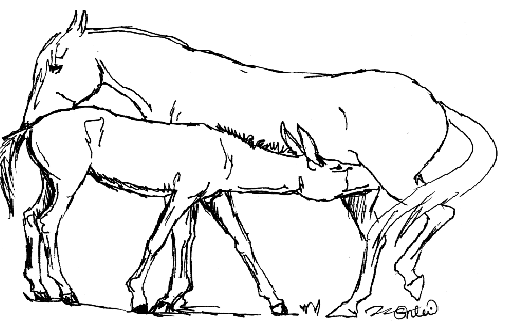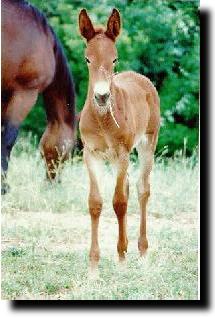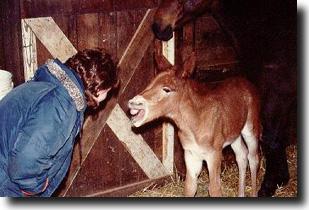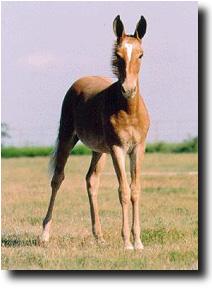|
WEANING
by Leah Posey Patton

Your strapping 8-month old mule colt has just completed his
self-appointed task of chasing every tiny monster that lurks under
bush and tree out of the pasture. Looking quite pleased with
himself, he snorts and high-steps over to Mom, and helps himself to
the milk bar. The old mare gives the colt a quizzical look, then
sighs, shakes her mane, and goes back to her grazing. Watching this
scene, you suddenly realize that the colt is as tall in the hip as
his dam! Yikes!!!
Should you wean him?
 What
is the correct age to wean a foal? There is really not a single
answer to this question. Most breeders will tell you that the best
age to wean is 6 months. For the most part, this is the best age.
However, there can be many factors that can change the age of
weaning. Each weaning should be evaluated on a case-to case basis.
No foal should be weaned before the age of three months unless is
becomes medically necessary for the health of either the foal or the
dam. Although time and again, very young foals have been
successfully bottle raised. However, if the dam can nurse the foal,
it is best. The foalís digestive system is set up to process milk
first and foremost, and not until after it is 3 months old or older
does is really begin to get the full nutritional value of other feed
such as grass, hay and grain. In addition, the bottle baby looks to
you as mom, and the bond between human mother, nursemaid and
playmate is even harder to convert to independent equine and human
handler. What
is the correct age to wean a foal? There is really not a single
answer to this question. Most breeders will tell you that the best
age to wean is 6 months. For the most part, this is the best age.
However, there can be many factors that can change the age of
weaning. Each weaning should be evaluated on a case-to case basis.
No foal should be weaned before the age of three months unless is
becomes medically necessary for the health of either the foal or the
dam. Although time and again, very young foals have been
successfully bottle raised. However, if the dam can nurse the foal,
it is best. The foalís digestive system is set up to process milk
first and foremost, and not until after it is 3 months old or older
does is really begin to get the full nutritional value of other feed
such as grass, hay and grain. In addition, the bottle baby looks to
you as mom, and the bond between human mother, nursemaid and
playmate is even harder to convert to independent equine and human
handler.

Young foals can and should have limited access to creep feed, but it
should not be their only source of nourishment. Avoid overfeeding
high-protein and rich feeds. Neither mules nor donkeys need as high
a protein content as horse colts. A colt that is six months old,
well grown, and eating other foods can probably be weaned without
any problem. A four-month old that is draining the mare dry with
each nursing, and causing her to lose flesh might be a prime
candidate for weaning.
Certainly, no foal should stay on the mare after 9-10 months of age.
The mareís milk has lost most of the nutritional content by then,
and suckling is simply done by the foal out of habit, for
contentment, and because the dam lets him get away with it. Many
mares will begin the weaning process on their own. In the wild, a
young stud would be driven away from the herd in the spring, and new
foals would be born, demanding the dams attention. Some mares
instinctively begin to kick at the colt when he comes to nurse,
signaling she is ready to end the nursing. Mares who are aggressive
about weaning their foal themselves will probably be successful. She
may kick, bite, and even whirl away and strike at him with front
feet and teeth. If she has room to get away from the colt, she might
drive him away or run off kicking at him.
Large breeding operations
rarely wait to see if mares will take care of weaning themselves.
Colts of a like age (perhaps 4-7 months) who are ready to be weaned
may all be taken off their dams at once. Forced weaning must be done
firmly. The colts are taken away from the dams all at once, and KEPT
SEPARATED. Losing your resolve and giving in to the pitiful whinnies
of Mom and the sobs of Baby after one day might result in a firmer
bond that is harder to break a second time.
 If you are weaning a male mule, if he has not already been gelded,
the excuse of having him away at the vets (or away from the mare) to
be gelded is good not to put him back in with his dam. Although some
feel that weaning and gelding at the same time puts too much stress
on the animal, both the condition of the foal and the dam should be
a consideration .
If you are weaning a male mule, if he has not already been gelded,
the excuse of having him away at the vets (or away from the mare) to
be gelded is good not to put him back in with his dam. Although some
feel that weaning and gelding at the same time puts too much stress
on the animal, both the condition of the foal and the dam should be
a consideration .
At whatever age you decide to wean, make sure that your facilities
are stout enough to do the job. You cannot put a mare and colt on
either side of a wire fence and expect that it will keep them apart.
Weanlings develop extraordinary powers of levitation and have been
known to teleport through gates and other solid, tall barriers. If
the urge to get back to mother is strong enough, he will find a way.
A flimsy wire fence can be jumped, crawled though, under, or simply
pushed over. He may even nurse through the fence. Barbed wire
fencing (common in this day and age) can spell disaster.
 Although most weanlings will go through a day of two of pacing,
crying and being off their feed, they usually resign themselves
after a few days and begin to behave normally. They can be turned
out with other colts at this point - but NOT back in with Mom. Mares
have been known to dry up after a few weeks, then have the colt put
back in with them and begin milking all over. Even if the mare does
not come back into milk, she may allow him to suckle again anyway
and youíre back to stage one.
Although most weanlings will go through a day of two of pacing,
crying and being off their feed, they usually resign themselves
after a few days and begin to behave normally. They can be turned
out with other colts at this point - but NOT back in with Mom. Mares
have been known to dry up after a few weeks, then have the colt put
back in with them and begin milking all over. Even if the mare does
not come back into milk, she may allow him to suckle again anyway
and youíre back to stage one.
A few colts
will go crazy at the mere IDEA of being separated from Mom. This is
when a good stout stall is required. He might bang or bruise himself
up a bit, but this is preferable to charging headlong into a fence
(of any kind) that he did not see, or refuses to acknowledge. A
quiet older companion in the next stall, a human monitor, and a long
vacation for Mom (preferably in a different section or the farm or
even another stable) are recommended. Out of sight, out of hearing
and vocal range can help the Out of Mind.
Colts should already be halter trained by the time they are ready to
wean - it will make everything a lot easier. Trying to lead a 600
pound unbroke colt away from Mom for the first lesson is probably
not going to work. Knowing how to stand tied will help also.
Although you donít want to leave him tied up in a stall or pen,
using lessons he has already learned to refocus his mind can help.
After the colt is weaned, he will need companionship - another colt,
an older animal, or even one of a different species. If these are
not available, he might rely on you to play his games, and he might
not know when to stop short of hurting you.
 The other factors that should be mentioned in deciding when to wean
are: age of the mare, breeding status of the mare, season of the
year, and of course, ownership of the foal. If you have sold the
colt and are to have it taken over by the new owners at weaning, do
you want to pull him off his dam and deliver him at once? Or are you
going to have him weaned and settled in before they pick him up. If
the buyers are relatively new to owning equines, DONíT give them an
unsettled weanling. If they are buying a lot of foals to raise and
train, and prefer to take weanling straight off the mare, then
discuss it beforehand with them. All in all, selling a settled
youngster is much more courteous, and will be easier on the colt as
well.
The other factors that should be mentioned in deciding when to wean
are: age of the mare, breeding status of the mare, season of the
year, and of course, ownership of the foal. If you have sold the
colt and are to have it taken over by the new owners at weaning, do
you want to pull him off his dam and deliver him at once? Or are you
going to have him weaned and settled in before they pick him up. If
the buyers are relatively new to owning equines, DONíT give them an
unsettled weanling. If they are buying a lot of foals to raise and
train, and prefer to take weanling straight off the mare, then
discuss it beforehand with them. All in all, selling a settled
youngster is much more courteous, and will be easier on the colt as
well.
The main thing to remember is safety for the animal, patience,
and TIME. It will take more than a few days for the process to take
place, and the colt will need extra attention. Give him the love and
care he will need, and you can have a happy, healthy weanling.
|